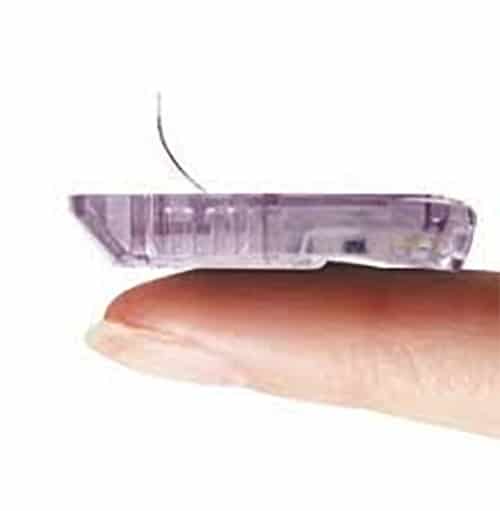Virtual Slipstream 2021 happened April 22-24. We had the team from Dexcom Canada join us to share more about the work that goes into diabetes product design and software engineering. Miss the session? Read on to find out the top things learned during Dexcom Canada’s Product Showcase with Apurv Kamath and Spencer Frank.
Disclaimer: Please check out CIM’s Partners Page to learn more about the companies we work with. This post was delivered as part of an event-specific sponsorship with our partner, but our partners do not review the content before publication and we strive to bring accurate and helpful information to the T1D online community. We still thought this info was important for you to know about.
At Virtual Slipstream 2021, Apurv Kamath and Spencer Frank joined the community to share more about diabetes product design and software engineering at Dexcom. Apurv joined Dexcom back in 2003, when the company was just a start-up. He has worked at Dexcom in research and development focused on software algorithms and now leads the company’s Product Management team. Spencer Frank is an algorithm engineer at Dexcom Canada. He was diagnosed with Type 1 diabetes in 2012 while traveling in Southeast Asia. He started working at Dexcom not long after, in 2014.
Here are a few things we learned from Apurv and Spencer:
The Dexcom Story
Back in 1967, the world saw the first step towards continuous glucose monitoring at the University of Wisconsin. It was here that Stuart J Updike and George P Hicks developed the first enzyme electrode, a development that allowed glucose and oxygen to be translated from body fluid into an electrical signal.
In 1981, Updike went on to help found Markwell Medical Institute, the creator of the very first home glucose meter. The meter was named the Direct 3030 and was distributed by Lilly.
In 1990, their team started working on a fully implantable CGM technology. This became the research that Dexcom was founded on in 1999. Dexcom’s first goal was to use the Markwell developments to create a fully implantable sensor with the original prototype being the size of a AAA battery!

Credit: Dexcom Investor Relations

Credit: Dexcom.com
In 2004, Dexcom decided to pivot it’s business model and move away from a fully implantable sensor, to a model that would allow glucose readings from a filament just under the skin. The first product trial began in 2004, with the sensor being sent to the FDA in early 2005. The very first Dexcom system was called the STS (Short Term Sensor.)
Elements of the Dexcom System
There are three main parts of the Dexcom System that help it to function: The Sensor & Membrane, the Sensor Geometry & materials, and the Algorithm. Each of these elements is constantly being worked on, evaluated and improved so that each iteration of the Dexcom system is better than the one previous.
Sensor & Membrane
This is the polymer chemistry that controls the flux of glucose and oxygen from the body fluid to the sensor electrode. Although you might expect that the magic happens just by simply inserting the Dexcom sensor and letting the filament sit under your skin, there has been a lot of important research and development made to help the process to actually function.
Sensor Geometry & Materials
The actual part that senses glucose under the skin is a platinum (yep, you heard us right – platinum!) filament that drives the electrochemical reaction. Next time you pull out your sensor take a look at that filament. Did you know it was made from one of the most valuable minerals on earth?

Credit: Dexcom.com
The Algorithm
Another important part of the Dexcom system, and one that is constantly being worked on and improved is the algorithm. The data processing algorithm is what turns the electrical signal produced into glucose readings that are meaningful and accurate to the user.
The Evolution of the Dexcom CGM
Over the years, there have been several iterations of the Dexcom CGM system.
STS (Short Term Sensor)
This sensor was named as such because as it was coming to market, Dexcom was also working on another sensor. You may have guessed: The LTS (Long Term Sensor). It had a bulky, handheld display (known as the receiver), required manual insertion, and lasted just 3 days. Part of the reason that it came to market with a 3-day wear window was related to the amount of time that infusion sets which were already being used in the diabetes community, were worn for.
G4
The G4 sensor extended wear from 3 days to 7 days and came with a receiver that was modeled after mp3 players that were popular at the time. It also had improved accuracy compared to previous models.

Credit: Dexcom.com
G6
This version of the Dexcom system allowed users to display readings on a smart phone, instead of needing to carry an additional device. A spring-loaded applicator was designed for easier insertion following years of manual insertion and wear was increased to 10 days. Accuracy was also improved through changes to the sensor chemistry and algorithm code.

Credit: Dexcom.com
Factory Calibration
One of the biggest improvements with the G6 system has been factory calibration, meaning, no more need for finger sticks. We were interested to learn more about how this actually works during Virtual Slipstream.
Dexcom measures each and every sensor that is created in the factory before it is packaged and shipped out. Because sensors are being manufactured en masse, there is room for slight differences between each sensor including the length of the filament and the membrane characteristics, each thing that can impact the accuracy of the sensor. Once each sensor is measured, it is assigned a group based on the characteristics it shares with other sensors. These groups are then assigned a code that becomes its sensor code. This code, when entered into the receiver or app, helps the system to know what changes need to be made in order to ensure a top level of accuracy.
Device and Data Partnerships
The Dexcom G6 system was designed purposefully to work well with partners in the industry. During the Product Showcase session at Virtual Slipstream, we learned about just a few of the partners that Dexcom is currently working with. These include:
For more information on upcoming Connected in Motion events, visit our events page, here.





